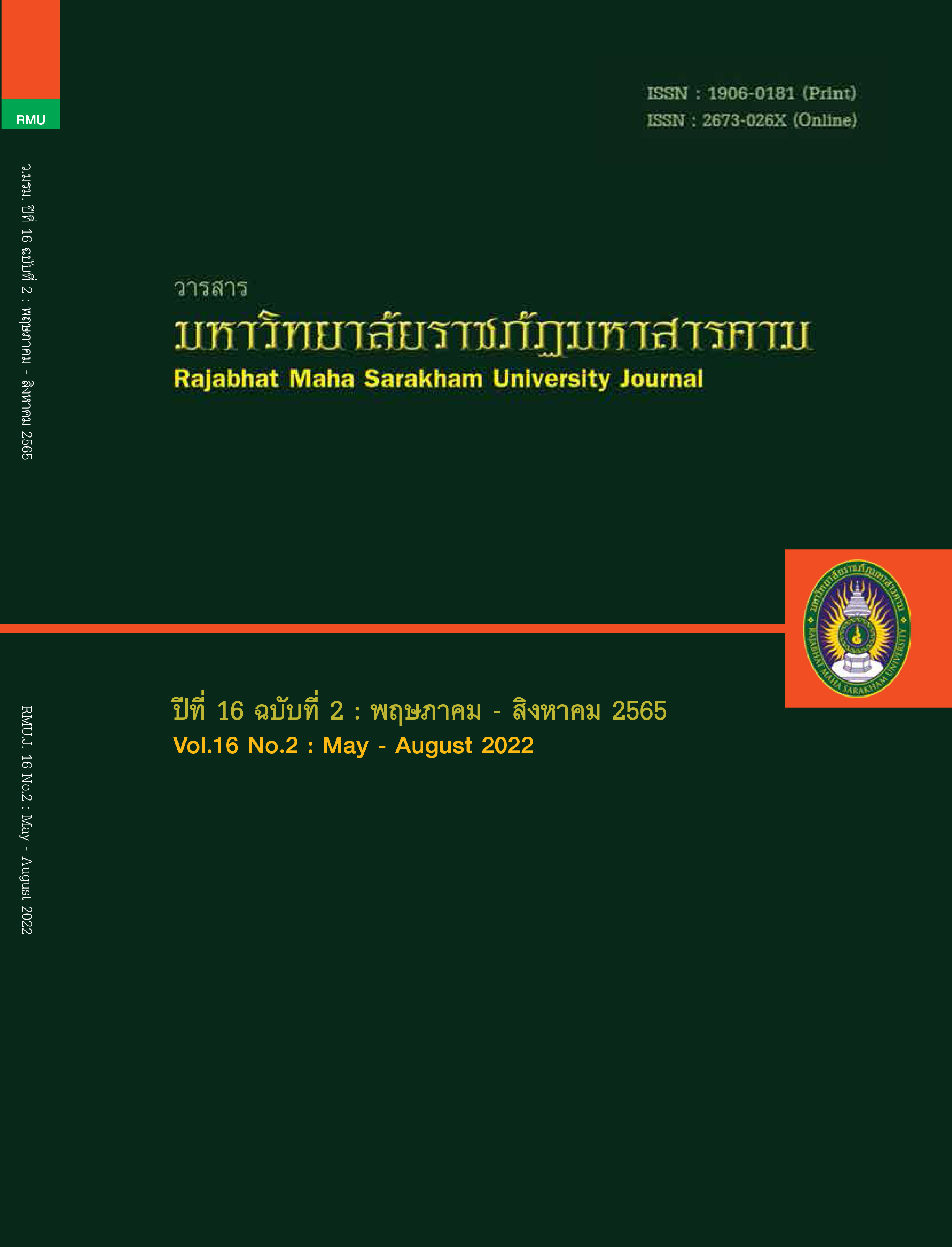The Development of Learning Achievement and Mathematical Problem-Solving Skills on Exponential Function by Using SSCS Model Together with KWDL Technique of Grade 10 Students
Main Article Content
Abstract
This action research aims 1. to compare learning efficiency in mathematics of Grade 10 students between before and after using SSCS model with KWDL technique 2. to compare problem-solving skills in mathematics between before and after using SSCS model with KWDL technique measuring by quality criteria, and 3. to survey Grade 10 students’ attitude towards learning by using SSCS model with KWDL technique. This action research’s sample is 33 students of class 8, Grade 10, Princess Sirindhorn's College, Nakhon Pathom in 2nd semester of academic year 2020. The sample was randomized by cluster random sampling. The action research instruments include: 1. 8 lesson plans about exponential function. The means are between 4.75 to 4.90 which are in the highest quality criteria. 2. Mathematics achievement test about exponential function (four-multiple choice). The Index of Item-Objective Congruence (IOC) is 1.00. The Difficulty Indices (p) are between 0.37 to 0.78. The Discrimination Indices (r) are between 0.34 to 0.87. The Reliability by using KR20 formular is 0.73. 3. Mathematical problem-solving skills test (write-up). The Index of Item-Objective Congruence is 1.00. The Difficulty Indices are between 0.66 to 0.67. The Discrimination Indices are between 0.50 to 0.57. The Reliability by using Cronbach’s Alpha formular () is 0.82. and 4. The satisfaction survey of Grade 10 students towards learning mathematics by using SSCS model with KWDL technique (five-rating scale). The internal consistency of the items and the objectives is 1.00. The statistical tools used for analyzing data include the mean, the standard deviation and the hypothesis using t-test for dependent sample.
The action research results are as follows:
- Mathematical learning efficiency in Grade 10 students after using SSCS model with KWDL technique in Grade 10 students (
= 6.70, S.D. = 2.23) is higher than before using SSCS model with KWDL technique in Grade 10 students (
= 3.24, S.D. = 2.05) with .05 statistical significance.
- Mathematical problem-solving skills in Grade 10 students after using SSCS model with KWDL technique in Grade 10 students (
= 20.27, S.D. = 4.42) is higher than before using SSCS model with KWDL technique in Grade 10 students (
= 5.33, S.D. = 4.33) The quality criteria are in the excellent level (
= 2.54, S.D. = 0.74)
- The satisfaction survey towards learning by using SSCS model with KWDL technique in Grade 10 students is in the very satisfied level (
= 4.18, S.D. = 0.77)
- .
Article Details

This work is licensed under a Creative Commons Attribution-NonCommercial-NoDerivatives 4.0 International License.
1. All articles undergo a thorough with at least three reviewers evaluating their suitability within the respective field of study, during the double-blind review.
2. The views expressed by individual authors do not represent the official views of the Editorial Boards of RMUJ: The author of each articie is responsible for all its contents.
3. The Editorial Boards do not reserve the copyrights. but proper citations need to be made.
References
กระทรวงศึกษาธิการ. (2560). ตัวชี้วัดและสาระการเรียนรู้แกนกลาง กลุ่มสาระการเรียนรู้คณิตศาสตร์ (ฉบับปรับปรุง พ.ศ.2560) ตามหลักสูตรแกนกลางการศึกษาขั้นพื้นฐาน พุทธศักราช 2551. กรุงเทพฯ: โรงพิมพ์ชุมนุมสหกรณ์การเกษตรแห่งประเทศไทย จำกัด.
จุฑามาศ หงษ์คำ. (2557). การพัฒนากิจกรรมการเรียนรู้คณิตศาสตร์โดยใช้รูปแบบร่วมมือกันเรียนรู้เทคนิค STAD ที่เน้นการแก้ปัญหาแบบ SSCS เรื่อง ทฤษฎีบทพีทาโกรัส ชั้นมัธยมศึกษาปีที่ 2. วารสารศึกษาศาสตร์ มหาวิทยาลัยขอนแก่น, 37(4), 21.
ซัฟฟียะห์ สาและ. (2561). ผลการจัดการเรียนรู้ด้วยเทคนิค KWDL เรื่องค่ากลางของข้อมูล ที่มีต่อผลสัมฤทธิ์
ทางการเรียนและความสามารถในการสื่อสารทางคณิตศาสตร์ของนักเรียนชั้นมัธยมศึกษาปีที่ 5. วารสารศึกษาศาสตร์ มหาวิทยาลัยนเรศวร, 20(4), 35.
ทรงพล ศรีอาคะ. (2564). ผลการจัดการเรียนรู้ด้วยเทคนิค เค ดับเบิ้ลยู ดี แอล ที่มีต่อความสามารถการแก้โจทย์ปัญหาและผลสัมฤทธิ์ทางการเรียนวิชาคณิตศาสตร์ของนักเรียนชั้นมัธยมศึกษาปีที่ 1. วารสารบัณฑิตวิจัย Journal of Graduate Research, 12(1), 71.
ธันยพัฒน์ พันธุ์พำนัก. (2562). การจัดการเรียนรู้ด้วยรูปแบบ SSCS เพื่อส่งเสริมผลสัมฤทธิ์ทางการเรียนและทักษะการแก้ปัญหาทางคณิตศาสตร์ เรื่อง ความน่าจะเป็น
ชั้นมัธยมศึกษาปีที่ 3. วารสารวิชาการ Veridian E – Journal, Silpakorn University, 12(4), 339.
ปวีณา บัวเขียว. (2562). การพัฒนากิจกรรมการจัดการเรียนรู้คณิตศาสตร์ เรื่อง เรขาคณิตวิเคราะห์ ของนักเรียนชั้นมัธยมศึกษาปีที่ 4 โดยใช้รูปแบบการจัดกิจกรรมการเรียนรู้ตามทฤษฎีคอนสตรัคติวิสต์ร่วมกับการจัดกิจกรรมการเรียนรู้แบบ SSCS. วารสารบัณฑิตวิทยาลัย พิชญทรรศน์, 14(1), 99.
ปิยะดา ลื่นกลาง. (2562). การพัฒนาทักษะการแก้โจทย์ปัญหา เรื่อง อัตราส่วนและร้อยละ ของนักเรียนชั้นมัธยมศึกษาปีที่ 2 โดยการจัดการเรียนรู้แบบร่วมมือด้วยเทคนิค STAD ร่วมกับเทคนิค KWDL. วารสารวิทยาศาสตร์และวิทยาศาสตร์ศึกษา, 2(2), 147.
พิฌาวรรณ แช่มชื่น ชมดง. (2560). ผลของการจัดกิจกรรมการเรียนรู้คณิตศาสตร์ตามรูปแบบ SSCS ร่วมกับการกระตุ้นโดยใช้คำถามที่มีต่อความสามารถในการแก้ปัญหาและการให้เหตุผลทางคณิตศาสตร์ ของนักเรียนชั้นมัธยมศึกษาตอนปลาย. วารสารอิเล็กทรอนิกส์ทางการศึกษา, 12(1), 639.
มณีรัตน์ พันธุตา. (2557). การศึกษาความสามารถในการแก้ปัญหาคณิตศาสตร์และผลสัมฤทธิ์ทางการเรียนของนักเรียนชั้นมัธยมศึกษาปีที่ 4 โดยใช้รูปแบบ SSCS ร่วมกับกระบวนการแก้ปัญหาของ POLYA. วารสารศึกษาศาสตร์ ฉบับวิจัยบัณฑิตศึกษา มหาวิทยาลัยขอนแก่น, 8(4), 106.
เมธาสิทธิ์ ธัญรัตนศรีสกุล. (2557). การพัฒนาทักษะการแก้ปัญหาทางคณิตศาสตร์ เรื่อง โจทย์ปัญหาสมการเชิงเส้นตัวแปรเดียว ของนักเรียนความสามารถพิเศษทางคณิตศาสตร์ระดับชั้นมัธยมศึกษาปีที่ 1 โรงเรียนเบญจมราชูทิศ ราชบุรี ที่จัดการเรียนรู้ด้วยรูปแบบ SSCS. วารสารวิชาการราชภัฏตะวันตก, 9(1), 66.
วลัยพร โล่เส็ง. (2560). การศึกษาความสามารถในการแก้ปัญหาคณิตศาสตร์และการคิดอย่างมีวิจารณญาณ ของนักเรียนชั้นมัธยมศึกษาปีที่ 4 โดยใช้รูปแบบ SSCS ร่วมกับเทคนิค KWDL. วารสารศึกษาศาสตร์ ฉบับวิจัยบัณฑิตศึกษา มหาวิทยาลัยขอนแก่น, 11(1), 143.
อรุณี เต็งศรี. (2563). ผลการจัดกิจกรรมการเรียนรู้วิชาคณิตศาสตร์ เรื่อง พื้นที่ผิวและปริมาตร โดยใช้เทคนิค KWDL ที่มีผลต่อทักษะการแก้ปัญหาและผลสัมฤทธิ์ทางการเรียนคณิตศาสตร์ของนักเรียนชั้นมัธยมศึกษาปีที่ 3. วารสารครุศาสตร์ปริทรรศน์ฯ, 7(3), 107.
อิฟฟัต กาเดร์. (2560). ผลของการจัดการเรียนรู้วิธีการแบบเปิด (Open Approach) ร่วมกับรูปแบบ SSCS ที่มีต่อผลสัมฤทธิ์ทางการเรียนวิทยาศาสตร์ ความสามารถในการแก้ปัญหา และความพึงพอใจต่อการจัดการเรียนรู้ ของนักเรียนชั้นมัธยมศึกษาปีที่ 4. วารสาร AL – NUR บัณฑิตวิทยาลัย มหาวิทยาลัยฟาฏอนี, 12(22), 23.
Diani R. (2019). Search, Solve, Create, and Share (SSCS) Learning Model: The Impact on the Students’ Creative Problem-Solving Ability on the Concept of Substance Pressure. Jurnal Penelitian Fisika dan Aplikasinya (JPFA), (01), 65.

